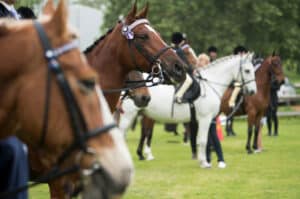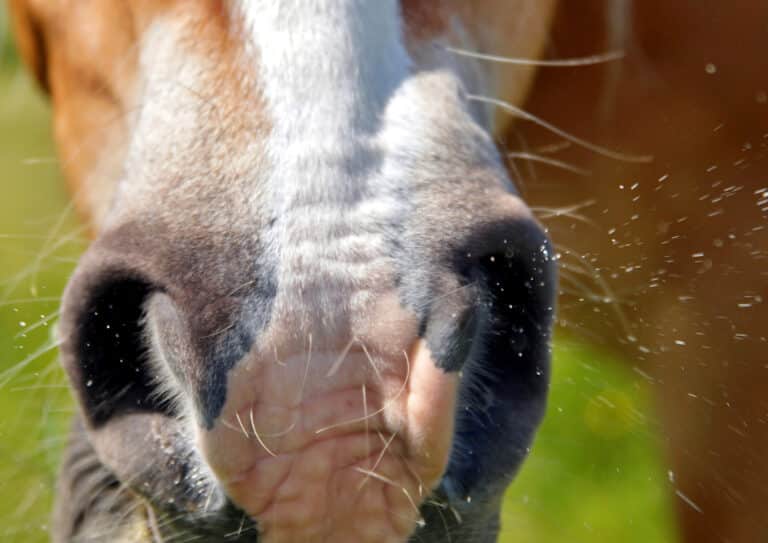Breathe easy
Respiratory disease can affect any horse. Dr CLARE WILLIAMS-PATERSON of Apiam Equine Services explains various approaches to treatment, and offers some expert tips on prevention.
Respiratory disease is a common cause of morbidity and/or loss of performance in horses across all ages, breeds, and disciplines. Signs of respiratory disease are usually self-evident and vary according to cause. However, they will often include a nasal discharge, an abnormal respiratory noise, a cough, changes in normal breathing patterns and a below-expected performance level. Additional historical details such as the duration of the signs, any recent travel, contact with other horses, or a recent fever, also provide important information.
The challenge with respiratory disease is in making a specific diagnosis. As equine veterinarians, our goals in the diagnostic evaluation of respiratory issues in horses are to localise the problem (lower vs upper respiratory tract), to confirm if the cause is infectious or non-infectious, and to determine the severity and consequences of the condition.

Viral respiratory infections
These are considered the most important causes of respiratory disease in horses worldwide. In Australia the equine herpes viruses (EHV) are common culprits. Any viral damage to the defence mechanisms of the respiratory tract increases the risk for the development of a secondary bacterial pneumonia.
We should also keep in mind that Hendra Virus is a zoonotic disease of horses in Australia, causing severe and rapidly fatal respiratory or neurologic disease in horses and humans.
Bacterial respiratory infections
These infections are also commonly reported in horses. Many owners know about Streptococcus equi equi, the causative agent of strangles. This is a primary bacterial pathogen of the upper respiratory tract and is highly infectious among horses.
Rhodococcus equi is a primary bacterial pathogen of the lower respiratory tract of foals that produces chronic suppurative (in which pus is formed and/or discharged) bronchopneumonia and pulmonary abscessation. With another breeding season under way now, we are on the look-out for this common respiratory issue in our foal populations. Clinical signs can be mild until disease is advanced, so close observation is key.

Horses that travel
Horses that travel long distances are particularly prone to developing a pleuropneumonia, commonly referred to as travel sickness or shipping fever. Pleuropneumonia is a bacterial infection that not only affects the lungs but also extends into the space around the lungs. Despite travel being a normal event in the lives of many horses, many owners are unaware that it can adversely affect their horse’s health.
Stress related to travel, head position during travel, changes in ventilation and air quality, and length of transport are all contributing factors. However, travel sickness tends to affect horses travelling the longer distances and is not normally associated with short term travel.
Chronic disease
Chronic, non-septic inflammatory disease of the lower airways is a common respiratory condition that affects adult horses of various ages – and yes, we are talking about equine asthma (EA). This allergen-mediated condition is characterised by inflammation, hypersensitivity and remodelling of the airways in response to dust and mould in the environment.
The prevalence of EA in horses is higher than most of us realise. Horses with mild to moderate EA are typically younger to middle age and experience decreased performance and sometimes a cough. When trigger factors are removed these horses typically improve with a low recurrence rate.
In contrast, horses with severe equine asthma are commonly older horses (often seven years plus) and present with frequent coughing and exercise intolerance – many of these guys exhibit respiratory distress even when at rest.
Environmental modification is the mainstay of treatment for EA, in conjunction with prescribed medications when necessary.
There are many additional respiratory issues that we encounter with horses, both on a regular and intermittent basis – the list is way too long to cover in this brief article.
Diagnostic tools
Important diagnostic tests, that we as equine veterinarians use in the investigation of respiratory conditions in our patients, include endoscopy (upper and lower airway), respiratory tract fluid analysis, and imaging of the respiratory tract (radiography, ultrasonography).
Endoscopy is an essential tool for direct visual examination of the upper respiratory tract including the nasal passages, ethmoid turbinates, opening of maxillary sinuses, guttural pouches, larynx, and trachea. Endoscopy at rest often provides a definitive diagnosis; however, dynamic respiratory endoscopy allows for evaluation of the horse during exercise on a treadmill or when ridden, identifying conditions for which clinical signs may not be present at rest.
Imaging is essential for diagnosis of upper respiratory conditions in particular. Radiographs of the skull are useful in the investigation of sinus condition, dental abnormalities and facial deformities.
Thoracic radiography and ultrasonography are valuable for assessing lower respiratory tract disease. Thoracic ultrasonography is the most appropriate technique to evaluate fluid in the pleural space and peripheral pulmonary abscessation
A nasopharyngeal swab, flush culture or PCR are indicated tests for upper respiratory conditions such as suspected strangles or a viral infection.
The most important technique for evaluating lower respiratory tract secretions is a lung-wash (the fancy term is bronchoalveolar lavage). This technique is indicated for cytologic evaluation (the diagnosis of disease at a cellular level) of the lower respiratory tract in horses with non-infectious pulmonary disease such as EA, or exercise-induced pulmonary haemorrhage (EIPH).
Treating the disease
Treatment for horses with respiratory disease varies dramatically according to the cause – there is no blanket approach or set formula. However, regardless of the type of respiratory disease, environmental factors and supportive care are important to aid recovery. For example, a dust and ammonia-free stable environment prevents further damage to the respiratory tract lining.
Adequate hydration and nutrition assist in decreasing the viscosity of respiratory secretions thus facilitating their removal from the lower respiratory tract.
Vaccinations
Vaccination remains the cornerstone of prevention for many infectious respiratory pathogens in horses and should be a part of your preventative management plan. Whilst vaccination does not always prevent respiratory infections, regular vaccination can lessen the duration and severity of some diseases. In Australia, vaccines are commercially available for strangles and EHV (types 1 and 4), and Hendra Virus. Vaccination recommendations will vary according to the use of each individual horse and their potential for exposure to infectious animals.

Biosecurity protocols
Vaccination is not a substitute for good management practices – so do not solely rely on it! Horse owners can minimise the spread of infectious organisms by adhering to a well-planned biosecurity protocol. Be a proactive horse owner. For example, make a habit of washing/sanitising your hands when moving from horse to horse, and don’t share tack or equipment between horses. This simple practice alone is an important start because respiratory infections spread through groups of horses by inhalation and by direct contact between animals, handlers and contaminated surfaces. And consider quarantine (ideally up to four weeks) for all animals brought onto your property, especially those returning from events such as shows or sales.
One key point is when traveling with horses, use your own water buckets. Some viruses and bacteria can survive in communal watering points. Taking the temperatures of all traveling horses twice daily is a must. Know your horse’s normal temperature! And take temperatures after returning home from a trip!
Given the variety of respiratory presentations and causes early veterinary intervention is recommended to identify the best treatment protocols and to deliver the best outcome.
Visit Apiam Animal Health to learn more about their range of services.



